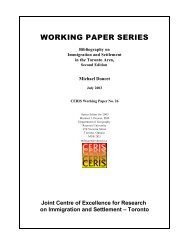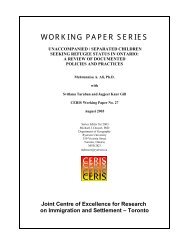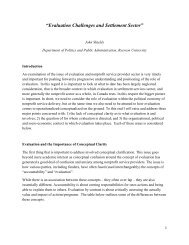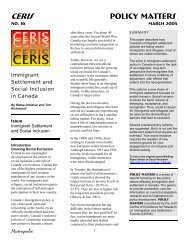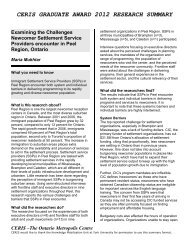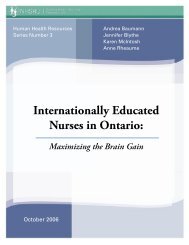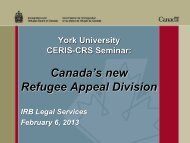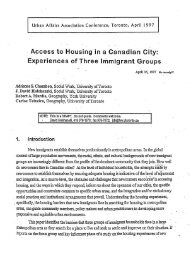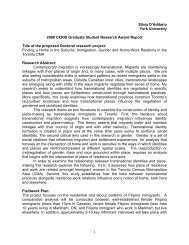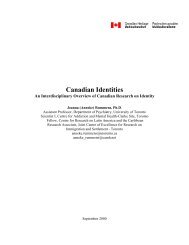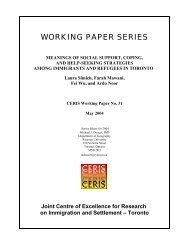question, described above. The “Canadian” response was disregarded for respondents who gave anyo<strong>the</strong>r answer <strong>in</strong> addition. This reduced <strong>the</strong> number <strong>of</strong> “Canadian” responses to just 5.2 percent <strong>of</strong> <strong>the</strong>population.Comb<strong>in</strong><strong>in</strong>g GroupsAlthough <strong>the</strong> Census is a very, very large survey, it was still necessary to set a m<strong>in</strong>imum size for <strong>the</strong>ethno-racial groups to be analyzed. The questions about ethnicity and racial identification, as well as <strong>the</strong>detailed questions about education, jobs and <strong>in</strong>come, are <strong>in</strong>cluded on what is known as <strong>the</strong> “long form” <strong>of</strong><strong>the</strong> Census questionnaire, which is distributed to every fifth dwell<strong>in</strong>g; <strong>the</strong> o<strong>the</strong>r four fifths <strong>of</strong> dwell<strong>in</strong>gsreceive a short questionnaire that allows <strong>the</strong> entire population to be counted and classified accord<strong>in</strong>g toage and a few o<strong>the</strong>r characteristics.Even though <strong>the</strong> long form Census collects <strong>in</strong>formation about 450,000 <strong>in</strong>dividuals, <strong>the</strong>re were notenough responses to produce reliable statistics for some groups, for example people who are Nigerian,Guatemalan or Welsh. So it was necessary to comb<strong>in</strong>e some ethno-racial groups <strong>in</strong> larger categories,even if <strong>the</strong> result was to hide potentially <strong>in</strong>terest<strong>in</strong>g detail. For example, <strong>the</strong> different Central Americanorig<strong>in</strong>s were comb<strong>in</strong>ed, even though <strong>the</strong> result is that Costa Ricans, who come to Canada from a stableand relatively prosperous nation, cannot be separated from <strong>the</strong> Guatemalans, Nicaraguans andSalvadoreans who come from much poorer countries, which have also experienced civil war.The guidel<strong>in</strong>e, roughly, was to comb<strong>in</strong>e groups so that at least 500 Census returns were available foreach group. Due to <strong>the</strong> one <strong>in</strong> five sample, <strong>the</strong>se respondents speak for communities with at least 2,500members. Among <strong>the</strong> o<strong>the</strong>r comb<strong>in</strong>ed groups are: “o<strong>the</strong>r African nations,” which <strong>in</strong>cludes all Africannationalities, except for Ethiopians, Ghanaians and Somalis (for whom <strong>the</strong>re is sufficient data for separateanalysis); “o<strong>the</strong>r Caribbean nations,” which excludes Barbadians, Guyanese, Jamaicans, (<strong>the</strong> comb<strong>in</strong>ation<strong>of</strong>) Tr<strong>in</strong>idadians and Tobagonians, and “West Indians,” a regional category used by Census respondents<strong>the</strong>mselves “o<strong>the</strong>r East/Sou<strong>the</strong>ast Asian and Pacific Islanders”; and so on.Like any sample survey, <strong>the</strong> Census results are subject to sampl<strong>in</strong>g error: one would not obta<strong>in</strong>exactly <strong>the</strong> same answers if a new sample had been selected, even at exactly <strong>the</strong> same moment as <strong>the</strong> first.For produc<strong>in</strong>g aggregate statistics, such as <strong>the</strong> age distribution, <strong>the</strong> m<strong>in</strong>imum population <strong>of</strong> 2500 isacceptable, but for smaller ethno-racial groups <strong>the</strong> Census sample is not large enough to provide areasonable basis for estimates <strong>of</strong> youth unemployment and o<strong>the</strong>r characteristics <strong>of</strong> smaller subgroups. In<strong>the</strong> Tables, three dashes are used to <strong>in</strong>dicate that cannot be estimated reliably.<strong>Ethno</strong>-<strong>Racial</strong> <strong>Inequality</strong> <strong>in</strong> <strong>Toronto</strong>: <strong>An</strong>alysis <strong>of</strong> <strong>the</strong> 1996 Census 7
“Multiple” ResponsesClassify<strong>in</strong>g <strong>the</strong> nearly one-third <strong>of</strong> <strong>Toronto</strong>nians who gave two or more answers to <strong>the</strong> questionabout <strong>the</strong>ir orig<strong>in</strong>s required a series <strong>of</strong> steps, which progressively cut down <strong>the</strong> number <strong>of</strong> peoplerema<strong>in</strong><strong>in</strong>g to be classified. Most comb<strong>in</strong>ations <strong>of</strong> orig<strong>in</strong>s <strong>in</strong>volve nationalities from <strong>the</strong> same globalregion or reflect traditional patterns <strong>of</strong> migration, such as from South Asia to <strong>the</strong> Caribbean. Only oneexact comb<strong>in</strong>ation <strong>of</strong> ancestries, for French and British orig<strong>in</strong>s, <strong>in</strong>cluded enough <strong>in</strong>dividuals to be used asa separate category. In o<strong>the</strong>r cases, it was necessary to group <strong>the</strong> responses. For example, people withEnglish and Italian ancestry were classified <strong>in</strong> <strong>in</strong> <strong>the</strong> more general category for “British and o<strong>the</strong>rEuropean.”Individuals who identified <strong>the</strong>mselves <strong>in</strong> terms <strong>of</strong> a “racial” group that was consistent with <strong>the</strong>irnational orig<strong>in</strong>, such as <strong>the</strong> comb<strong>in</strong>ation <strong>of</strong> “Spanish” and “Argent<strong>in</strong>ian” or “Jamaican” and “Black” wereclassified with <strong>the</strong>ir nationality, <strong>in</strong> <strong>the</strong>se cases Argent<strong>in</strong>ian and Jamaican, respectively. Respondentswhose responses referred to <strong>the</strong> same global region were placed <strong>in</strong> general categories for that region, suchas South American and South Asian. There are also separate categories for two or more Britishethnicities, such as Scottish and Irish (“Multiple British”), and for two or more Sou<strong>the</strong>rn Europeannationalities (“Multiple Sou<strong>the</strong>rn Europe”).Individuals who reported two or more dissimilar orig<strong>in</strong>s were classified accord<strong>in</strong>g to <strong>the</strong> mostvisible group. For example, people who were Aborig<strong>in</strong>al and French were placed <strong>in</strong> <strong>the</strong> category for“Aborig<strong>in</strong>al and British or French,” and placed with <strong>the</strong> Aborig<strong>in</strong>al ethnic groups <strong>in</strong> <strong>the</strong> Tables below;and people who were African and Indian were classified as “African and South or East Asian,” andlocated with <strong>the</strong> African ethno-racial groups. The order <strong>of</strong> “visibility” used to def<strong>in</strong>e <strong>the</strong>se comb<strong>in</strong>edcategories was: Aborig<strong>in</strong>al, African or Black, South Asian, East or Sou<strong>the</strong>ast Asian, Arab and WestAsian, European.A small number <strong>of</strong> respondents were reclassified on a more ad hoc basis. For example, people whogave <strong>the</strong>ir orig<strong>in</strong> as “Spanish” who were born <strong>in</strong> Mexico or Central or South America were classifiedaccord<strong>in</strong>g <strong>in</strong> <strong>the</strong> Americas.These pr<strong>in</strong>ciples resulted <strong>in</strong> a classification with 89 ethno-racial categories. Most refer tonationalities based on nation states or, for smaller groups, on larger global regions. A few <strong>of</strong> <strong>the</strong>categories are more “racial” <strong>in</strong> tone, such as “East Indian”; <strong>the</strong> rema<strong>in</strong>der <strong>in</strong>volve cross-regionalcomb<strong>in</strong>ations such as Caribbean and South Asian.In this classification, a person who <strong>in</strong>dicates that she is, say, Barbadian and <strong>in</strong> <strong>the</strong> next question<strong>in</strong>dicates that she is White or (more likely) Ch<strong>in</strong>ese, is <strong>in</strong>cluded <strong>in</strong> <strong>the</strong> predom<strong>in</strong>antly Black category <strong>of</strong><strong>Ethno</strong>-<strong>Racial</strong> <strong>Inequality</strong> <strong>in</strong> <strong>Toronto</strong>: <strong>An</strong>alysis <strong>of</strong> <strong>the</strong> 1996 Census 8
- Page 6 and 7: origin, South Asians, Arab and West
- Page 8 and 9: Table of ContentsExecutive Summary.
- Page 10 and 11: IntroductionThis Report provides de
- Page 12 and 13: Methodological NotesThis Report pro
- Page 14 and 15: Chapter 1Defining Ethno-Racial Grou
- Page 18 and 19: “Barbadians.” Likewise, people
- Page 20 and 21: acial identification question, redu
- Page 22 and 23: Table 1, continuedEthno-Racial Grou
- Page 24 and 25: percentage of a group has the need.
- Page 26 and 27: ARAB AND WEST ASIAN ORIGINSApproxim
- Page 28 and 29: EUROPEAN ORIGIN GROUPS TEND TO BE O
- Page 30 and 31: The key question involves the numbe
- Page 32 and 33: Table 2, continuedPercentage and Nu
- Page 34 and 35: A second policy concern involves th
- Page 36 and 37: NON-NATIONAL, “RACIAL” AND MULT
- Page 38 and 39: Table 3, continuedKnowledge of Engl
- Page 40 and 41: majority of people speak English. T
- Page 42 and 43: Fully 96.1 percent of Torontonians
- Page 44 and 45: Chapter 2EducationIf educational cr
- Page 46 and 47: Table 4, continuedHighest Level of
- Page 48 and 49: Ethno-Racial Inequality in Toronto:
- Page 50 and 51: Educational Attainment of AdultsAbo
- Page 52 and 53: EUROPEAN ORIGINAmong Europeans, edu
- Page 54 and 55: GROUPS WITH HIGHER PROPORTIONS OF N
- Page 56 and 57: Table 5, continuedSchool Attendance
- Page 58 and 59: Ethno-Racial Inequality in Toronto:
- Page 60 and 61: Of most concern are the small numbe
- Page 62 and 63: Not counted as unemployed are “di
- Page 64 and 65: Table 6, continuedLabour Force Char
- Page 66 and 67:
Ethno-Racial Inequality in Toronto:
- Page 68 and 69:
percent for the African, Black and
- Page 70 and 71:
LATIN AMERICAN ORIGINSThe two Latin
- Page 72 and 73:
Table 7, continuedIncome from Emplo
- Page 74 and 75:
efore coming to Canada likely refle
- Page 76 and 77:
Table 8a, continuedOccupations of W
- Page 78 and 79:
Table 8bOccupations of Men by Ethno
- Page 80 and 81:
Table 8b, continuedOccupations of M
- Page 82 and 83:
Ethno-Racial Inequality in Toronto:
- Page 84 and 85:
eing an employee; just 3.2 percent
- Page 86 and 87:
Table 9, continuedIncidence of Self
- Page 88 and 89:
AFRICAN, BLACK AND CARIBBEAN ORIGIN
- Page 90 and 91:
esult in similar levels of income.
- Page 92 and 93:
Among the individual ethno-racial g
- Page 94 and 95:
Chapter 4Poverty and Individual and
- Page 96 and 97:
Introduction to the TablesThe first
- Page 98 and 99:
Table 10, continuedIncidence of Pov
- Page 100 and 101:
Ethno-Racial Inequality in Toronto:
- Page 102 and 103:
Table 11, continuedIncidence of Chi
- Page 104 and 105:
Ethno-Racial Inequality in Toronto:
- Page 106 and 107:
types of families are not an intuit
- Page 108 and 109:
children and 12.8 percent of Arab/W
- Page 110 and 111:
Table 12, continuedIncidence of Pov
- Page 112 and 113:
Southeast Asians and Pacific Island
- Page 114 and 115:
Table 13, continuedMedian Family In
- Page 116 and 117:
Ethno-Racial Inequality in Toronto:
- Page 118 and 119:
Table 14, continuedMedian Individua
- Page 120 and 121:
Ethno-Racial Inequality in Toronto:
- Page 122 and 123:
SOUTH ASIAN ORIGINSWhile just over
- Page 124 and 125:
LATIN AMERICAN ORIGINSDue to statis
- Page 126 and 127:
There are remarkable ethno-racial d
- Page 128 and 129:
Table 15, continuedHome Ownership o
- Page 130 and 131:
percent of Italian families own the
- Page 132 and 133:
The most severe disadvantage affect
- Page 134 and 135:
Men in Lower SkillJobs(Table 8b/Cha
- Page 136 and 137:
which included all other African na
- Page 138 and 139:
In Lower Skill Non-Manual Occupatio
- Page 140 and 141:
skilled non-manual occupations in 1
- Page 142:
segregation, the effects of unequal



